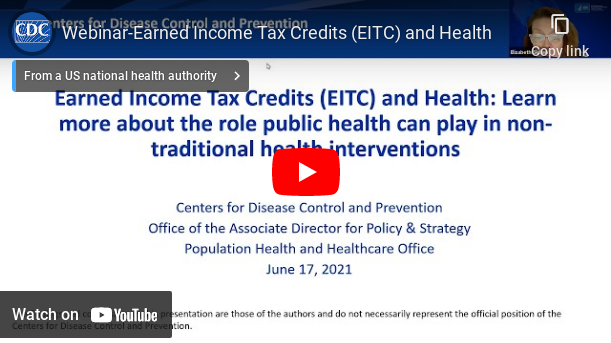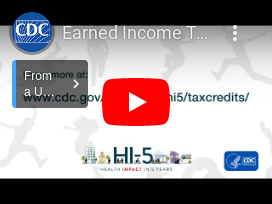Earned Income Tax Credits
Interventions Addressing the Social Determinants of Health
‹View Table of Contents

What is an Earned Income Tax Credit?
Earned income tax credit (EITC) is a benefit for working people with low to moderate income that the federal government, many states and some local communities offer.1, 2 It is designed to incentivize work and help reduce poverty, particularly for families with children.1,3 An EITC can act as an additional source of income when the benefit is set up as a refundable credit like the federal EITC and many state EITCs.3, 4 For example, the federal EITC could give a minimum wage worker with two kids up to 40% more income.5, 6
By reducing poverty and increasing income for working families, EITC has been linked to positive health outcomes, particularly for infants and mothers.5, 7-9 Studies show greater health improvements happen when larger, more generous EITC benefits are available.7, 10-11 Health systems and public health partners can reach out to eligible people to raise awareness of and accessibility to the tax credit.

Earned Income Tax Credits (EITCs) can improve health by lifting people out of poverty. In 2018, federal EITCs helped lift about 5.6 million people – half of them children – out of poverty.17
NewEarned Income Tax Credits (EITC) and Health: Learn more about the role public health can play in non-traditional health interventions.
Income Influences Health
There is a well-established relationship between income and health, especially between poverty and poor health.12-14 Income can influence people’s health in a variety of ways:
- Income can change people’s risk for one or more chronic diseases, like heart disease, diabetes, and stroke.15
- Many low-income families are unable to afford health insurance and healthcare, and they frequently do not have enough income to live in safe communities with adequate housing and schools. 15
- In many cases, low-income families do not have access to healthy food, parks or other physical activity facilities, and public transportation—all of which may improve health. 15
- Financial stress and insecurity that often accompany poverty can negatively affect health. 10, 15
Earned Income Tax Credits Can Improve Health for Mothers and Children
EITC can improve public health by helping to lift people out of poverty. Strong evidence consistently links low income to Adverse Childhood Experience (ACEs) exposures and children’s long-term health, educational, and social outcomes.16
- In 2018, federal EITC helped lift about 5.6 million people out of poverty – over half of them children . 17
- EITC has kept more children living above the poverty line than any other tax credit program.18
The existence of a state EITC is connected to a reduction in the low birthweight rate of infants (weight is less than 2500 grams, or about 5 lbs 8 oz). Low birthweight puts babies at risk for death and poor childhood health.19
- A 2019 study showed 23 states with an EITC saw a connection between EITC and reduction in low birthrate by 4 to 11 percent.10
- The same study found that states with the greatest reductions in low birthweight rates and greatest increases in birthweight all had refundable tax credits.10
Strong evidence connects low income to poor health and exposure to adverse childhood experiences. Earned Income Tax Credits (EITC) can improve health by providing additional income to working families.
EITC Influences Health and Economic Activity
In addition to positive health changes, earned income tax credits are also linked to increased economic activity at state and local levels.20-21
- A 2007 analysis of the economic impact of a federal EITC in California found that EITC payments contributed to more than $5 billion in business sales in the state and helped add nearly 30,000 jobs. If all eligible people had claimed their EITCs, their payments would have contributed to another $1.2 billion in business sales and 7,500 jobs.20
- National Conference of State Legislatures. Tax credits for working families: Earned Income Tax Credit (EITC). 2018. Available from: Tax Credits for Working Families: Earned Income Tax Credit (EITC). Accessed 2019 March 12.
- New York State Department of Taxation and Finance. New York City credits. 2019. Available from: New York City Credits. Accessed 2019 March 12.
- Internal Revenue Service. Earned Income Tax Credit (EITC). 2019. Available from: Earned Income Tax Credit (EITC). Accessed 2019 March 12.
- Internal Review Service. Do I qualify for EITC? 2018. Available from: Do I Qualify for EITC? Accessed 2019 March 12.
- Arno PS, Sohler N, Viola D, Schechter C. Bringing health and social policy together: the case of the earned income tax credit. Journal of Public Health Policy 2009;30(2):198–207.
- Internal Revenue Service. EIC Table, Publication 596 (2018), Earned Income Credit. Washington, DC: IRS; 2017. Available from: EIC Table. Accessed 12 March 2019.
- Hoynes H, Miller D, Simon D. Income, the Earned Income Tax Credit, and Infant Health. American Economic Journal: Economic Policy 2015, 7(1):172-211. Accessed 2018 July 5.
- Hamad R, Rehkopf DH. Poverty, pregnancy, and birth outcomes: a study of the earned income tax credit. Paediatr Perinat Epidemiol 2015;29(5):444–52.
- Chetty R, Friedman JN, Rockoff JE. New evidence on the long-term impacts of tax credits. Washington, DC: Internal Revenue Service; 2011. Available from: New Evidence on the Long-Term Impacts of Tax Credits. Accessed 2017 June 18.
- Markowitz S, Komro K, Livingston M, et al. Effects of state-level Earned Income Tax Credit laws in the U.S. on maternal health behaviors and infant health outcomes. Social Science & Medicine, 2017;197:67-75.
- Evans WN, Garthwaite CL. Giving mom a break: the impact of higher EITC payments on maternal health. Cambridge (MA): National Bureau of Economic Research; 2010.
- Marmot M, Wilkinson R. Social determinants of health. Oxford (UK): Oxford University Press; 2005.
- Bosworth B, Burtless G, Zhang K. Later retirement, inequality in old age, and the growing gap in longevity between rich and poor. Washington, DC: The Brookings Institution; 2016.
- Blackburn C. Poverty and health: working with families. Maidenhead (UK): Open University Press; 1991.
- Woolf S, Aron L, Dubay L, Simon S, Zimmerman E, Luk K. How are income and wealth linked to health and longevity? Urban Institute Center for Health Policy, 2015. Available from: How are Income and Wealth Linked to Health and Longevity? Accessed 2019 March 12.
- Centers for Disease Control and Prevention (2019). Preventing Adverse Childhood Experiences: Leveraging the Best Available Evidence. Atlanta, GA: National Center for Injury Prevention and Control, Centers for Disease Control and Prevention.
- Center on Budget and Policy Priorities. How much would a state Earned Income Tax Credit Cost in Fiscal Year 2021? 2020. Available from: How Much Would a State Earned Income Tax Credit Cost in Fiscal Year 2021? Accessed 2021 August 25.
- Hoynes H. Proposal 11: building on the success of the earned income tax credit. In: Improving safety net and work support. Washington, DC: The Hamilton Project; 2014. Available from: Building on the Success of the Earned Income Tax Credit. Accessed 2017 June 18.
- Strully KW, Rehkopf DH, Xuan Z. Effects of prenatal poverty on infant health: state earned income tax credits and birth weight. American Sociological Review 2010;75(4):534–62.
- Avalos A, Alley S. The economic impact of the Earned Income Tax Credit (EITC) in California. California Journal of Politics and Policy 2010;2(1):Art. 17 [25 screens]. Available from: The Economic Impact of the Earned Income Tax Credit (EITC) in California. Accessed 2017 June 18.
- Haskell J. The state of the earned income tax credit in Nashville: an analysis of economic impacts and geographic distribution of the ‘working poor’ tax credit, TY 1997–2004. Nashville (TN): Vanderbilt University; 2006.
- CDC’s Division of Violence Prevention. Can State Earned Income Tax Credits Help Prevent Adverse Childhood Experiences? Available from: Can State Earned Income Tax Credits Help Prevent Adverse Childhood Experiences? Accessed 2021 Aug 25.
- CDC Foundation. Public Health Action Guide: Earned Income Tax Credit. Accessed 2021 Aug 25.
- CDC’s National Center for Injury Prevention and Control: Preventing Adverse Childhood Experiences: Data to Action (PACE: D2A). Accessed 2022 January 6.
- Sutphen O. The state of the Earned Income Tax Credit. LegisBrief, 2018;26(03). Available from: The State of Earned Income Tax Credit. Accessed 2019 March 14.
- Robert Wood Johnson Foundation, University of Wisconsin Population Health Institute. County health rankings & roadmaps: Earned Income Tax Credit (EITC). 2015. Available from: Earned Income Tax Credit (EITC) . Accessed 2015 Nov 25.
- Internal Revenue Service. I received a letter from the IRS about my credit; what should I do? 2019. Available from: I Received a Letter from the IRS about My Credit; What Should I Do? Accessed 2019 December 9.
- Grovum J. Renewed push for earned income tax credit in states. USA TODAY 2014 Feb 11. Available from: Renewed Push for Earned Income Tax Credit in States. Accessed 2016 June 7.
- Paille J. Earned Income Tax Credits: Employee notification requirements. Thomson Reuters Tax & Accounting. 2015. Available from: Earned Income Tax Credits: Employee Notification Requirements. Accessed 2018 May 14.
- City and County of San Francisco. What is the Working Families Credit (WFC)? 2016. Available from: What is the Working Families Credit (WFC)? Accessed 2016 Jun 6.
- Hole MK, Marcil LE, Vinci RJ. Improving Access to Evidence-Based Antipoverty Government Programs in the United States, A Novel Primary Care Initiative. JAMA Pediatr. 2017;171(3):211-212.
- Minnesota 2-1-1. Tax Help. Greater Twin Cities United Way. Available from: Tax Help. Accessed 2018 June 12.
- Internal Revenue Service. EITC & other refundable credits. About EITC. 2018. Available from: About EITC. Accessed 2019 March 12.
- Wicks-Lim J, Arno PS. Improving population health by reducing poverty: New York’s earned income tax credit. Amherst (MA): Political Economy Research Institute, University of Massachusetts–Amherst; 2015.
- Montgomery County Government. Earned income credit EIC refund. Available from: Earned Income Credit EIC Refund. Accessed 2019 March 12.
- Hair NL, Hanson JL, Wolfe BL. Association of child poverty, brain development, and academic achievement. JAMA Pediatrics 2015;169(9):822–29.
- Semega J, Kollar M, Shrider E, Creamer J. Income and poverty in the United States: 2019. Current Population Reports, Report Number P60-270 (RV). United States Census Bureau. Washington, DC: U.S. Government Publishing Office; 2020. Available from: Income and Poverty in the United States: 2019. Accessed 2021 December 16.
- Brooks-Gunn J, Duncan GJ, Leventhal T, Aber JL. Lessons learned and future directions for research on the neighborhoods in which children live. In: Brooks-Gunn J, Duncan GJ, Aber JL, eds. Neighborhood Poverty, Vol. 1: Context and Consequences for Children. New York (NY): Russell Sage Foundation; 1997. p. 279–97.
All HI-5 Interventions
- School-based Programs to Increase Physical Activity
- School-Based Violence Prevention
- Safe Routes to School (SRTS)
- Motorcycle Injury Prevention
- Tobacco Control Interventions
- Access to clean syringes
- Pricing Strategies for Alcohol Products
- Multi-Component Worksite Obesity Prevention
- Early Childhood Education
- Clean Diesel Bus Fleets
- Public Transportation System: Introduction or Expansion
- Home Improvement Loans and Grants
- ›Earned Income Tax Credits
- Water Fluoridation


